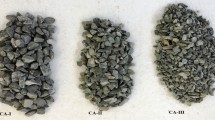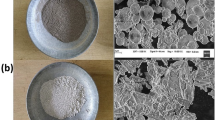Abstract
A novel high-strength straight-hole recycled pervious concrete (HSRPC) for the secondary highway pavement was prepared in this paper. This study aimed to investigate the effect of porosity (0.126%, 0.502%, and 1.13%), vehicle loading stress level (0.5 and 0.8) and service life on the resistance to rainstorm-based waterlogging of HSRPC under fatigue loading. The mechanical properties of HSRPC in terms of flexural strength and dynamic elastic modulus were studied. The waterlogging resistance of HSRPC was described by surface water depth and drainage time. The microstructure of HSRPC were observed with scanning electron microscopy (SEM). Results showed that although the dynamic elastic modulus and flexural strength of HSRPC decreased with the increasing number of fatigue loading, the flexural strength of HSRPC was still greater than 5 MPa after design service life of 20 years. After 2.5×105 times of fatigue loading, the permeability coefficient of HSRPC with a porosity of 0.502% and 1.13% increased by 18.4% and 22.9%, respectively; while the permeability coefficient of HSRPC with 0.126% porosity dropped to 0.35 mm/s. The maximum surface water depth of HSRPC with a porosity of 0.126%, 0.502%, and 1.13% were 8, 5 and 4 mm, respectively. SEM results showed that fatigue loading expanded the number and width of cracks around the tiny pores in HSRPC.
Similar content being viewed by others
References
Yu H M, Zhao Y L, Fu Y C, et al. Spatiotemporal Variance Assessment of Urban Rainstorm Waterlogging Affected by Impervious Surface Expansion: A Case Study of Guangzhou, China[J]. Sustainability, 2018, 10: 3 761
Ma S Q, Lyu, S R, Zhang, Y D. Weighted Clustering-based Risk Assessment on Urban Rainstorm and Flood Disaster[J]. Urban Climate, 2021, 39: 100 974
Wu M M, Wu Z N, GE W, et al. Identification of Sensitivity Indicators of Urban Rainstorm Flood Disasters: A Case Study in China[J]. Journal of Hydrology, 2021, 599: 126 393
Zhu H, Yu M, Zhu J, et al. Simulation Study on Effect of Permeable Pavement on Reducing Flood Risk of Urban Runoff[J]. International Journal of Transportation Science and Technology, 2019, 8(4): 373–82
Zhu Y, Li H, Yang B, et al. Permeable Pavement Design Framework for Urban Stormwater Management Considering Multiple Criteria and Uncertainty[J]. Journal of Cleaner Production, 2021, 293: 126 114
Xie X G, Zhang T S, Wang C, et al. Mixture Proportion Design of Pervious Concrete Based on the Relationships between Fundamental Properties and Skeleton Structures[J]. Cement and Concrete Composites, 2020, 113: 103 693
Zhang J, Meng B W, Wang Z, et al. Numerical Simulation on Cleaning of Clogged Pervious Concrete Pavement[J]. Journal of Cleaner Production, 2022, 341: 130 878
Elizondo-Martinez EJ, Andres-Valeri VC, Jato-Espino D, et al. Review of Porous Concrete as Multifunctional and Sustainable Pavement[J]. Journal of Building Engineering, 2020, 27: 100 967
Lo F C, Lee M G, Lo S L, et al. Effect of Coal Ash and Rice Husk Ash Partial Replacement in Ordinary Portland Cement on Pervious Concrete[J]. Construction and Building Materials, 2021, 286: 122 947
Vazquez-Rivera NI, Soto-Perez L, St John JN, et al. Optimization of Pervious Concrete Containing Fly Ash and Iron Oxide Nanoparticles and Its Application for Phosphorus Removal[J]. Construction and Building Materials, 2015, 93: 22–28
Li J S, Zhang Y, Liu G L, et al. Preparation and Performance Evaluation of An Innovative Pervious Concrete Pavement[J]. Construction and Building Materials, 2017, 138: 479–85
Yang X L, Shen A Q, Guo Y C, et al. Deterioration Mechanism of Interface Transition Zone of Concrete Pavement under Fatigue Load and Freeze-thaw Coupling in Cold Climatic Areas[J]. Construction and Building Materials, 2018, 160: 588–597
Graeff A G, Pilakoutas K, Neocleous K, et al. Fatigue Resistance and Cracking Mechanism of Concrete Pavements Reinforced with Recycled Steel Fibres Recovered from Post-consumer Tyres[J]. Engineering Structures, 2012, 45: 385–395
Peng Q M, Wang L, LU Q. Influence of Recycled Coarse Aggregate Replacement Percentage on Fatigue Performance of Recycled Aggregate Concrete[J]. Construction and Building Materials, 2018, 169: 347–353
ARORA S, SINGH S P. Fatigue Strength and Failure Probability of Concrete Made with RCA[J]. Magazine of Concrete Research, 2017, 69(1–2): 55–67
Vicente MA, Gonzalez DC, Minguez J, et al. Influence of the Pore Morphology of High Strength Concrete on Its Fatigue Life[J]. International Journal of Fatigue, 2018, 112: 106–116
Li Z N, Shen A Q, Long H J, et al. Dynamic Deterioration of Strength, Durability, and Microstructure of Pavement Concrete under Fatigue Load[J]. Construction and Building Materials, 2021, 306: 124 912
Yuan J Y, Chen X D, Shen N, et al. Experimental Study on the Pore Structure Variation of Self-compacting Rubberised Concrete under Fatigue Load[J]. Road Materials and Pavement Design, 2019, 22: 716–733
Zhou J L, Zheng M L, Wang Q, et al. Flexural Fatigue Behavior of Polymer-modified Pervious Concrete with Single Sized Aggregates[J]. Construction and Building Materials, 2016, 124: 897–905
Yang F J, Hu D W, Zhou H, et al. Post-fatigue Properties of High-strength Concrete Subjected to Coupled 3D Fatigue-static Loading[J]. Construction and Building Materials, 2021, 306: 124 879
Sun X Y, Tian Y, Yin W W, et al. Effect of Free Water on Fatigue Performance of Concrete Subjected to Compressive Cyclic Load[J]. Construction and Building Materials, 2022, 318: 125 995
China Architecture and Building Press. Technical Specification for the Application of Self-compacting Concrete[S]. JGJ/T 283–2012, 2012
Niu Z G, Zhu P H, Chen C H, et al. Design Method of Novel Recycled Pervious Concrete for Resisting Rainstorm and Waterlogging[J]. Bulletin of the Chinese Ceramic Society, 2021, 40(01): 106–112
Tam VWY, Tam CM, Wang Y, et al. Optimization on Proportion for Recycled Aggregate in Concrete Using Two-stage Mixing Approach[J]. Construction and Building Materials, 2007, 21(10): 1 928–1 939
Feng J C, Zong N W, Zhu P H, et al. The Frost-resisting Durability of High Strength Self-Compacting Pervious Concrete in Deicing Salt Environment[J]. Journal of Wuhan University of Technology -Materials Science Edition, 2020, 35(01): 167–75
China Communications Press Co., Ltd. Technical Standards for Highway Engineering:[S]. JTG B01–2014, 2014
Zheng M L, Wang B G, Hu C S, et al. Study on Fatigue Properties of Porous Concrete[J]. China Journal of Highway and Transport, 2004, (01): 11–5
China Architecture and Building Press. Standard for Test Methods of Long-term Performance and Durability of Ordinary Concrete:[S]. GB/T 50082–2009, 2009
China Architecture and Building Press. Technical Specification for Pervious Cement Concrete Pavement:[S]. CJJ/T 135–2009, 2009
Ni Z N, Li Q F, Du F R, et al. Study on Design of Rainstorm Pattern Based on Short Duration in Nanjing City[J]. Journal of Water Resources and Water Engineering 2019, 30(02): 57–62
China Planning Press. Design Standards for Outdoor Drainage[S]. GB 50014–2021, 2021
Ballatore E, Bocco P. Variations in the Mechanical Properties of Concrete Subjected to Low Cyclic loads[J]. Cement and Concrete Research, 1997, 27(3): 453–462
Gonzalez DC, Moradillo R, Minguez J, et al. Postcracking Residual Strengths of Fiber-reinforced High-performance Concrete after Cyclic Loading[J]. Structural Concrete, 2018, 19(2): 340–351
Xiao J Z, Li H, Yang Z J. Fatigue Behavior of Recycled Aggregate Concrete under Compression and Bending Cyclic Loadings[J]. Construction and Building Materials, 2013, 38: 681–688
China Communications Press. Specification for Design of Road Cement Concrete Pavement[S]. JTG D40–2011, 2011
Li Z N, Shen A Q, Liu Y W, et al. Attenuation Behavior of Pavement Concrete under Rolling Load and Hydrodynamic Pressure Coupling[J]. Construction and Building Materials, 2022, 321: 126 344
AlShareedah O, Nassiri S. Pervious Concrete Mixture Optimization, Physical, and Mechanical Properties and Pavement Design: A Review[J]. Journal of Cleaner Production, 2021, 288: 125 095
Drake J, Bradford A. Assessing the Potential for Rehabilitation of Surface Permeability Using Regenerative Air and Vacuum Sweeping Trucks[J]. Journal of Water Management Modeling, 2013, 16: 303–317
Lu J Z, Zhu K F, Tian LZ, et al. Dynamic Compressive Strength of Concrete Damaged by Fatigue Loading and Freeze-thaw Cycling[J]. Construction and Building Materials, 2017, 152: 847–855
Shen A Q, Lin S L, Guo Y C, et al. Relationship between Flexural Strength and Pore Structure of Pavement Concrete under Fatigue Loads and Freeze-thaw Interaction in Seasonal Frozen Regions[J]. Construction and Building Materials, 2018, 174: 684–692
Li Y, Shen A Q, Lyu ZH, et al. Investigations of Chloride Ions Permeability of Pavement Concrete under Coupled Effect of Fatigue Loading and Hydrodynamic Pressure[J]. International Journal of Pavement Engineering, 2020: 1–16
Funding
Funded by the National Natural Science Foundation of China (No. 51878081) and Postgraduate Research & Practice Innovation Program of Jiangsu Province (No. SJCX21_1262)
Author information
Authors and Affiliations
Corresponding author
Rights and permissions
About this article
Cite this article
Zhu, P., Fan, H., Yan, X. et al. Effect of Fatigue Loading on the Mechanical Properties and Resistance of High-strength Straight-hole Recycled Pervious Concrete to Rainstorm-based Waterlogging. J. Wuhan Univ. Technol.-Mat. Sci. Edit. 38, 141–148 (2023). https://doi.org/10.1007/s11595-023-2676-x
Received:
Accepted:
Published:
Issue Date:
DOI: https://doi.org/10.1007/s11595-023-2676-x




